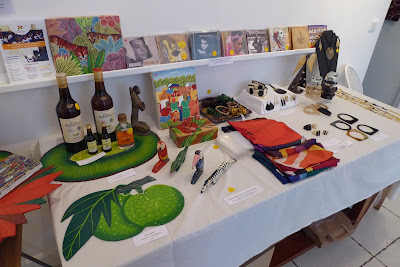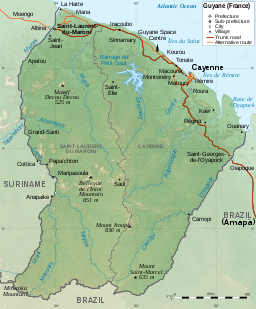Dorothy’s Gallery, American Center for the Arts, is partnering with the Haitian Embassy, the Haïti Jazz Foundation, Haïti Futur, Haïti Action Artistes and other organizations to celebrate 500 years of history and creative spirit in Haïti.
Dorothy Polley, gallery owner and founder of the American Center for the Arts, has opened her phenomenal exhibition space to these organizations in support of the reconstruction and continued development of Haïti in the wake of the 2010 earthquake.
Entering the gallery, you are greeted by an enormous collaborative painting by six artists from Jacmel in southeast Haïti.
Collaborative Painting by Artists from Jacmel (Southeast Haïti)
Acrylic on polycanvas
© Discover Paris!
All of the artists belong to Haïti Action Artistes, an association that was founded in 2011 with the intent to provide sustainable support for Haïtian artists and sculptors after the quake. It appealed to 650 artists in France and around the world to donate works for auction.
The proceeds financed a collaborative project called Tout Pou Youn, which furnishes imported art supplies to Haïtian artists at affordable prices. The association partnered with the Haïtian enterprise Matpar to create a line of acrylic paints that are locally available.
Also displayed in the gallery’s front room are mixed media works and drawings by Elodie Barthélémy, Eddy Saint-Martin, and Gérald Bloncourt.
Portrait en pieds 2012
Elodie Barthélémy
© Discover Paris!
Encombrement
Eddy Saint-Martin
2011 Mixed media on American box
© Discover Paris!
Haïti – 1804
Gérald Bloncourt
May 2015 Drawing on paper
© Discover Paris!
In the second room of the gallery, small canvases, works in wrought iron, artisan crafts, and books about Haïti are displayed.
Small canvases by various artists
© Discover Paris!
Mask in relief
Jacques Eugène
© Discover Paris!
Artisan crafts, rum, and CDs for sale
© Discover Paris!
Books by Mimi Barthélémy
© Discover Paris!
And in the spacious room at the rear of the gallery, mixed media works on textiles, oil paintings, and works in inks and pastels are on display.
L’Offrande
Gérald Bloncourt
1999 Oil on canvas
© Discover Paris!
Untitled
Eddy Saint-Martin
2014 Mixed media on cotton, hand painted
© Discover Paris!
Bloncourt works in ink, pastel, and oil
© Discover Paris!
Videos about various aspects of Häitian culture and contemporary life are available for viewing on a flat screen.
Video on education by Haïti Futur
© Discover Paris!
Haïtian Schoolgirls on video
© Discover Paris!
Eighty percent (80%) of all sales of art and crafts are donated to Haïti Action Artistes and Haïti Futur.
This unique and heart-centered exhibition runs through September 27, 2015.
Dorothy Polley
© Discover Paris!
Dorothy’s Gallery
27, rue Keller Paris
75011 Paris
Telephone: 01 43 57 08 51
E-mail:
Métro: Bastille (Lines 1, 5, 8), Voltaire (Line 9)
Hours: Wednesday to Saturday from 1 PM to 7 PM
Tuesday and Sunday from 4 PM to 7 PM
And also by appointment: contact the gallery for information and private visits.
************
If you like this posting, share it with your friends by using one of the social media links below!
Dorothy Polley, gallery owner and founder of the American Center for the Arts, has opened her phenomenal exhibition space to these organizations in support of the reconstruction and continued development of Haïti in the wake of the 2010 earthquake.
Entering the gallery, you are greeted by an enormous collaborative painting by six artists from Jacmel in southeast Haïti.
Acrylic on polycanvas
© Discover Paris!
All of the artists belong to Haïti Action Artistes, an association that was founded in 2011 with the intent to provide sustainable support for Haïtian artists and sculptors after the quake. It appealed to 650 artists in France and around the world to donate works for auction.
The proceeds financed a collaborative project called Tout Pou Youn, which furnishes imported art supplies to Haïtian artists at affordable prices. The association partnered with the Haïtian enterprise Matpar to create a line of acrylic paints that are locally available.
Also displayed in the gallery’s front room are mixed media works and drawings by Elodie Barthélémy, Eddy Saint-Martin, and Gérald Bloncourt.
Elodie Barthélémy
© Discover Paris!
Eddy Saint-Martin
2011 Mixed media on American box
© Discover Paris!
Gérald Bloncourt
May 2015 Drawing on paper
© Discover Paris!
In the second room of the gallery, small canvases, works in wrought iron, artisan crafts, and books about Haïti are displayed.
© Discover Paris!
Jacques Eugène
© Discover Paris!
© Discover Paris!
© Discover Paris!
And in the spacious room at the rear of the gallery, mixed media works on textiles, oil paintings, and works in inks and pastels are on display.
Gérald Bloncourt
1999 Oil on canvas
© Discover Paris!
Eddy Saint-Martin
2014 Mixed media on cotton, hand painted
© Discover Paris!
© Discover Paris!
Videos about various aspects of Häitian culture and contemporary life are available for viewing on a flat screen.
© Discover Paris!
© Discover Paris!
Eighty percent (80%) of all sales of art and crafts are donated to Haïti Action Artistes and Haïti Futur.
This unique and heart-centered exhibition runs through September 27, 2015.
© Discover Paris!
Dorothy’s Gallery
27, rue Keller Paris
75011 Paris
Telephone: 01 43 57 08 51
E-mail:
Métro: Bastille (Lines 1, 5, 8), Voltaire (Line 9)
Hours: Wednesday to Saturday from 1 PM to 7 PM
Tuesday and Sunday from 4 PM to 7 PM
And also by appointment: contact the gallery for information and private visits.
Entrée to Black Paris!™ is a Discover Paris! blog.
If you like this posting, share it with your friends by using one of the social media links below!


































